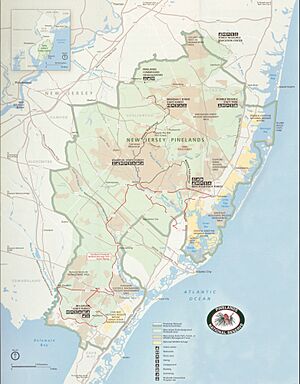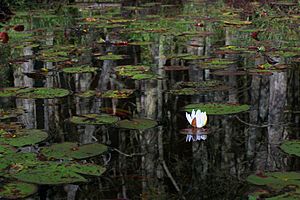New Jersey Pine Barrens facts for kids
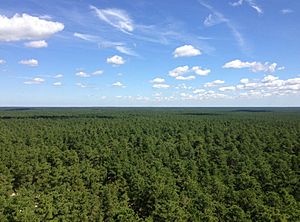
The New Jersey Pine Barrens, also called the Pinelands or just the Pines, is a huge natural area in New Jersey. It's the biggest example of a special kind of forest called the Atlantic coastal pine barrens ecosystem. This amazing place stretches across more than seven counties in New Jersey.
The name "pine barrens" might sound like it's a barren or empty place, but it actually refers to the sandy, acidic soil that doesn't have many nutrients. This soil made it hard for early European settlers to grow their usual crops. However, this unique environment is perfect for many different plants, including beautiful orchids and even carnivorous plants that eat insects! You can also find rare tiny pitch pines here. These plants need the frequent fires in the Pine Barrens to help them grow and spread their seeds. The sand in the soil is so fine that locals sometimes call it "sugar sand."
Even though it's close to big cities like Philadelphia and New York City, the Pine Barrens remains mostly wild and untouched. It's right in the middle of the busy Boston-Washington Corridor on the Eastern Seaboard. Important roads like the Garden State Parkway and Atlantic City Expressway go through parts of the Pine Barrens. This area is also super important because it helps refill the Kirkwood-Cohansey aquifer, which holds some of the purest water in the United States.
Because of its special nature, the U.S. Congress decided to protect the Pine Barrens in 1978. They made about 1.1 million acres (4,500 km²) of it the Pinelands National Reserve. This was the first National Reserve in the country! Later, in 1988, the United Nations named it an International Biosphere Reserve. This means it's recognized worldwide for its unique environment. A group called the New Jersey Pinelands Commission carefully controls any building or development in the Pinelands National Reserve to keep it safe.
The Pinelands Reserve includes several state forests like Wharton, Brendan T. Byrne, Penn, and Bass River. It also has two National Wild and Scenic Rivers: the Maurice and the Great Egg Harbor.
A famous book from 1967 by John McPhee, called The Pine Barrens, tells the story and explains the nature of this special region.
Contents
History of the Pine Barrens
How the Land Formed
The land that makes up the Pine Barrens started forming a very long time ago, between 170 and 200 million years ago. This was when the Atlantic coastal plain began to take shape. The Pine Barrens itself is one of the newest land areas in New Jersey, forming between 1.8 and 65 million years ago.
Over millions of years, the ocean's edge moved up and down, leaving minerals underground. After the last ice age ended about 12,000 years ago, plants and trees began to grow in what is now New Jersey.
Wildfires have always been a natural part of the Pine Barrens. Fire has played a huge role in shaping this area, helping certain plants and trees to grow.
Early People and European Settlers
About 10,000 years ago, the ancestors of the Lenape people were the first to live in the Pine Barrens. They would burn parts of the woods in spring and fall. This helped clear out thick bushes, made plants grow better, and improved hunting.
Since the sandy soil wasn't good for farming, not many people settled permanently in the Pine Barrens. This meant that people often set fires to help themselves, even on land that belonged to others. For example, people who made charcoal would sometimes set fires on purpose. This made the trees only useful for charcoal, so they could buy them cheaply.
In the 1600s, explorers from Sweden and the Netherlands came to New Jersey. The English later claimed the area in 1664. The first shipbuilding businesses started in the Pine Barrens in 1688. They used local cedar, oak, and pitch pine trees, along with tar and turpentine. Around 1700, the first sawmills and gristmills opened, leading to the first European towns in the Pinelands.
Industries and Inventions
During the colonial times, many industries grew in the Pine Barrens. In 1740, people started making charcoal here. The first iron furnace opened in 1765. They mined "Bog iron" from bogs and streams. This iron was used to make weapons and tools for the American military during wars like the American Revolution and the War of 1812. For instance, cannons used by Commodore Stephen Decatur Jr. in 1814 were made at Hanover Furnace.
The first Indian reservation in the Americas was founded in 1758 at Brotherton, which is now Indian Mills. During the Revolutionary War in 1778, the British attacked Chestnut Neck to try and destroy the ironworks at Batsto Village, but they failed.
After the war, the first glassworks opened in 1799. By the 1830s, people started growing cranberry bogs. The first paper mill opened in 1832. In 1854, the first railroad was built across the Pinelands, connecting Camden to the new city of Atlantic City. Soon, railroads linked many small towns in the Pine Barrens.
The bog iron industry ended in 1869 when cheaper iron ore was found in Pennsylvania. Other industries like paper mills and sawmills came and went. Over time, the forest grew back, covering most signs of the Pine Barrens' industrial past. You can still find ghost towns—old villages built around these industries. Batsto Village has been restored and is now a state historic site.
Efforts to Protect the Pine Barrens
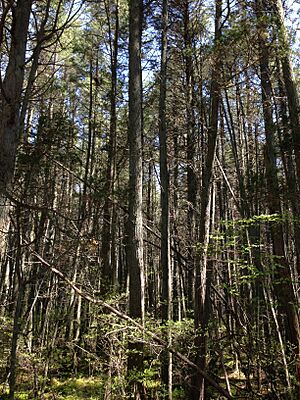
Even though areas around it were growing fast, the Pine Barrens stayed mostly wild. This was because its sandy soil wasn't good for most crops, and its iron and charcoal weren't as easy to get as other places. In 1969, the Pine Barrens had only about 15 people per square mile, while nearby areas had 1,000!
As people became more worried about the environment, they realized the Pine Barrens and its important water supply could be destroyed by too much building. There were even plans to build a huge airport and city in the Pine Barrens.
To protect this special place, Congress created the New Jersey Pinelands National Reserve in 1978. This was the first National Reserve in the country.
The office of Dr. James Still, a famous 19th-century "Black Doctor of the Pines," was bought by New Jersey in 2006 to be preserved. It's now a historic site and education center.
The Pinelands Reserve includes Wharton State Forest, Brendan T. Byrne State Forest, Bass River State Forest, and Penn State Forest. In 1983, UNESCO named the Pinelands a U.S. Biosphere Reserve, and an International Biosphere Reserve in 1988.
Howard P. Boyd worked hard to protect the Pine Barrens and teach people about it. He passed away in 2011, still living within the protected area.
Legends and Tales
The Pine Barrens is famous for many spooky legends and tales.
The Jersey Devil
The most famous legend from the Pine Barrens is the Jersey Devil. The story says it was born in 1735 to a local woman named Mrs. Leeds in Leeds Point. Some say it was her 13th child and was cursed. Another version says she gave birth to a horrible monster that attacked her and her nurses, then flew out of the chimney and vanished into the Barrens. Many people claim to have seen the Jersey Devil roaming the Pine Barrens on dark nights.
There are many other ghost stories and folk legends connected to the Pine Barrens. These include tales about the ghost of the "Black Doctor," the ghost of Captain Kidd, the "Black Dog," and other ghosts. There are also stories about the Blue Hole and other mysterious "blue holes" in the area.
Geography
The New Jersey Pinelands National Reserve covers about 1.1 million acres (4,500 km²) of land. This is about 22% of New Jersey's total land area! It includes parts of seven counties: Atlantic, Burlington, Camden, Cape May, Cumberland, Gloucester and Ocean.
The Pine Barrens is a big part of the Atlantic coastal pine barrens ecoregion, which is a type of natural area.
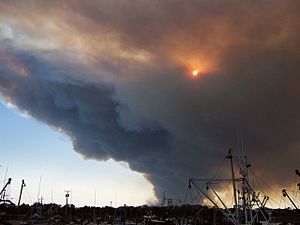
While natural fires happen, most fires in this region are caused by humans.
Climate
The Pine Barrens of New Jersey has a special climate. It's a mix between warm, humid weather and colder, continental weather. The Pine Barrens also has its own "microclimate." This means it has a shorter time without frost and colder nights compared to most of New Jersey.
Because of the sandy soil and not much development, clear, calm nights can be much colder in the Pine Barrens than in nearby areas. It's common for the temperature to be 6 to 8 degrees Fahrenheit (3 to 4 degrees Celsius) colder, and sometimes even 10 degrees Fahrenheit (5.5 degrees Celsius) colder!
The Pine Barrens gets snow every year, usually between 15 to 21 inches (38 to 53 cm). The northern parts get the most snow. Summers are usually hot and humid, and winters are cold. Spring and fall are milder. Frost can appear in fall, spring, and winter. In the Pine Barrens, frost comes earlier in the fall and stays later in the spring because of the sandy soil.
The average rainfall in the Pinelands is about 42 to 46 inches (107 to 117 cm) per year. However, the amount of rain can change a lot from year to year. Thunderstorms are common in warmer months, bringing strong winds and heavy rains.
Flora (Plants)
The Pine Barrens is home to at least 850 different kinds of plants! About 92 of these are considered threatened or endangered. Several types of orchids, like the Pink Lady's Slipper, grow naturally here. The area also has more than 20 kinds of wild berries, including wild raisin, red chokeberry, highbush blueberry, huckleberry, bearberry, and cranberry.
The plant communities are greatly affected by fire. You can find tiny "dwarf pine forests" less than 4 feet (1.2 meters) tall where fires happen often. In other places, you'll see taller pine forests, or even oak forests where fires are rare. Dark swamps of Atlantic white cedar trees grow along the rivers and streams.
Forest fires are very important for the plants in the Pine Barrens. Frequent, small fires help reduce thick undergrowth and allow mature trees to grow well. Fires have helped pitch pine trees become common in the Pine Barrens. These trees can survive and recover quickly from fire by growing new shoots directly from their bark, which is very unusual for pines! Their special pine cones, called serotinous cones, only open after being heated by a fire. This allows their seeds to spread. Because of fires, pitch pines often grow more than oaks, which are usually killed by strong fires.
There's a debate about how to best protect the Pine Barrens when it comes to fires. While fires can be dangerous to homes and people, many experts believe that stopping all fires would cause oak trees to take over the Pine Barrens. In some areas where fires have been stopped, oak trees have indeed replaced the scrub and pitch pines.
Fauna (Animals)
The Pine Barrens is home to many different animals. It has at least 39 types of mammals, over 300 kinds of birds, 59 reptile and amphibian species, and 91 types of fish. About 43 species are considered threatened or endangered by New Jersey. These include the rare eastern timber rattlesnakes and bald eagles.
A threatened frog species, the Pine Barrens tree frog, lives here. American black bears are also returning to the Pine Barrens after being hunted and trapped out of the area long ago.
The bobcat was thought to be gone from New Jersey by 1970 because its habitat was destroyed and people moved into its areas. It was given legal protection in 1972. Between 1978 and 1982, 24 bobcats from Maine were brought into the northern part of the state. Since 1996, scientists have been watching them using GPS trackers to learn about their homes and habits.
In 1995, a survey showed that bobcats were present in four northern counties. There have also been reliable sightings of bobcats in nine other counties, mostly in the southern part of the state, including those that cover large parts of the Pine Barrens. These counties include Atlantic, Burlington, Cape May, Cumberland, Ocean, and Salem.
Economy
The main industries in the Pine Barrens are farming and tourism.
Agriculture (Farming)
New Jersey is the third-biggest producer of cranberries in the country. Most of these are grown around Chatsworth, including at Whitesbog. The first cultivated blueberries were developed in the Pine Barrens in 1916 by Elizabeth Coleman White of Whitesbog. Blueberry farms are almost as common as cranberry bogs in the area. Most blueberry farms are found near the town of Hammonton.
Highways in the Pine Barrens
- Toll highways:
 A.C. Expressway
A.C. Expressway G.S. Parkway
G.S. Parkway
- U.S. highways:
- State highways:
 Route 37
Route 37 Route 47
Route 47 Route 49
Route 49 Route 50
Route 50 Route 54
Route 54 Route 68
Route 68 Route 70
Route 70 Route 72
Route 72
- County roads:
 CR 526
CR 526 CR 527
CR 527 CR 528
CR 528 CR 530
CR 530 CR 532
CR 532 CR 536
CR 536 CR 537
CR 537 CR 539
CR 539 CR 541
CR 541 CR 542
CR 542 CR 547
CR 547 CR 563
CR 563 CR 571
CR 571 CR 575
CR 575
In Popular Culture
The Pine Barrens has appeared in many TV shows, movies, and books.
- The TV show The Sopranos has an episode called "Pine Barrens". However, this episode was not actually filmed in the New Jersey Pine Barrens.
- John McPhee's book, The Pine Barrens (1968), explores the history, nature, and geography of the area. His book helped people understand how important pine barrens are for protecting underground water supplies.
- The Fantastic Four comic book heroes visit the Barrens in a 2004 story. They meet aliens who have been visiting the Barrens for many years, which supposedly led to the legend of the Jersey Devil.
- The 2012 movie The Barrens, starring Stephen Moyer, is set here and involves a story about the New Jersey Devil.
- Aurelio Voltaire's 2013 horror novel Call of the Jersey Devil is also set in the New Jersey Pine Barrens.
- Survivalist Tom Brown Jr.'s autobiography, The Tracker, tells how he learned his survival skills in the Pine Barrens.
Images for kids
-
Kayaking on the Mullica River
-
Fire tower on Apple Pie Hill


